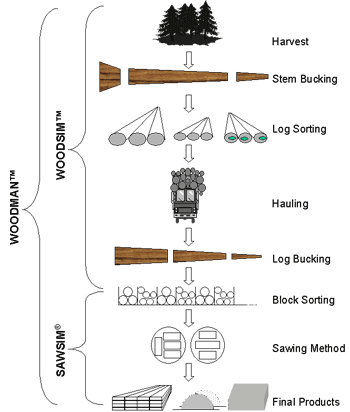Software
WOODMAN™
WOODMAN™ System
The WOODMAN™ system is a business model for operations-wide optimization of forest products operations, from the forest to the finished product. It is designed for any combination of harvesting operations, log purchases and sales, sawmills, panel plants, pulpwood, and chip supply to pulp mills.
|
Typical Fibre Flow Diagram |
|---|
 |
The software consists of the following components:
- the WOODSIM™ program, which simulates operations from trees through to the production of logs or blocks (bolts) suitable for sale, sawing, peeling, flaking or pulpwood;
- the SAWSIM® program, which is used to simulate sawing of blocks, through to rough green lumber, chips and other by-products;
- the components of the PANELSIM™ program which are used to simulate peeling operations, through to green veneer, chips and cores; plywood operations from green veneer, though to finished plywood panels; LVL operations from green veneer though to finished LVL panels and I-Joists; OSB operations from bolts, though to finished OSB panels;
- the HALTAB™ data management system which includes the HalcoMenu program, which is the entry point for all programs and utilities, the HalcoEdit™ and HalcoMiner™ programs.
WOODMAN™ produces an MS Access database containing the input data and the results, from which standard reports, including all wood and cash flows and operating times, etc., a projected operating statement, and custom reports can be generated. The standard reports contain the volumes of all inputs and outputs, and the values of all operating variables. A complete fiber balance across each stage of all processes is included.
The WOODMAN™ system is an example of HALCO's approach to optimization. This is to develop detailed models of each step in the process, and to validate these against test runs where available, and also against historical operating statistics for periods similar in length to the periods being modeled.
By developing detailed models, the user can be confident that situations for which there is no operating experience, where there have been equipment modifications, for instance, but which should be considered by the optimizing procedure, will be modeled with accuracy. The need for mill tests is greatly reduced, and in any case, because of random variations between tests, test runs are often poor predictors of the effect of changes in operating parameters.
